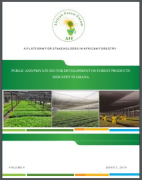This study was commissioned by the African Forest Forum to analyze the nature and trends in primary and secondary forest production in Ghana with emphasis on public and private sector contribution to the development of the sector and organization of production activities. The aim is to strengthen the capacity of the industry to address both social and environmental concerns that contribute to sustainable, equitable and effective private sector development in forestry. The information presented in this report is a synthesis of qualitative and quantitative primary data from interviews of selected forest sector institutions and individuals, augmented with published and grey literature on the forestry sector of Ghana. Forestry contributes 6% to GDP of Ghana and provides livelihoods for about 15% (3.6 million) of the Ghanaian population. Natural forests including tree resources on farmlands are the main sources of supply for timber and non-timber products in Ghana. Over 50 products are extracted from both humid forests and savannah woodlands across the country. The most frequently exploited products for subsistence and commercial purposes include wild foods (mainly game meat, fruits, nuts, mushrooms, snails, etc.) fuelwood, construction materials (timber, poles, rattan, bamboo) and medicines. There are over 27 forest-based enterprises, majority of which are in the small and medium enterprise category, that contribute significantly to local livelihoods and the national economy. The forestry sector of Ghana is characterized by a wide range of public and private sector stakeholders in both primary and secondary forest production. The public sector consists of government institutions primarily responsible for policies, programs, development of resource capacity including technical skill by academic and research institutions for forest management. The private sector constitutes civil society and non-governmental organizations, communities, firms and individuals, among others, engaged in both commercial and non-profit activities involved in advocacy, commerce and other developments in the forestry sector. Private sector contribution to the national economy in the forestry sector has largely been in forest plantation, timber production and processing. The forestry sector contributes 6% of the Gross Domestic Product (GDP) and employs a labour force of over 75,000 people, whilst providing direct livelihood to about two million people. Foreign exchange earning from timber by the end of the third quarter of 2015 was Euro 135 million. Private sector contribution, with respect to the nontimber forest product sector, on the other hand has had minimum official attention, hence not adequately quantified. It has largely been operated by informal or private small and medium scale enterprises using rudimentary technologies whose activities are often unregulated and has hardly been governed by public sector policies and programs.

